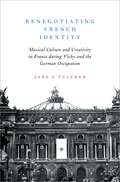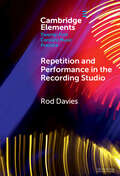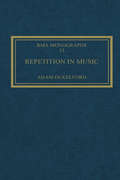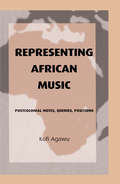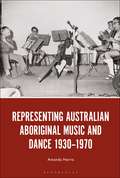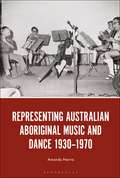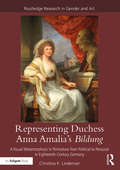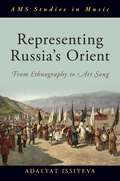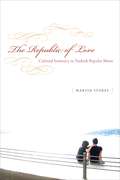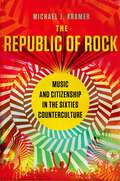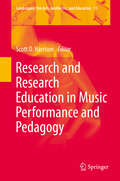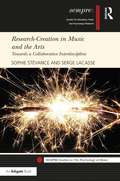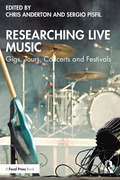- Table View
- List View
Renegotiating French Identity: Musical Culture and Creativity in France during Vichy and the German Occupation
by Jane F. FulcherIn Renegotiating French Identity, Jane Fulcher addresses the question of cultural resistance to the German occupation and Vichy regime during the Second World War. Nazi Germany famously stressed music as a marker of national identity and cultural achievement, but so too did Vichy. From the opera to the symphony, music did not only serve the interests of Vichy and German propaganda: it also helped to reveal the motives behind them, and to awaken resistance among those growing disillusioned by the regime. Using unexplored Resistance documents, from both the clandestine press and the French National Archives, Fulcher looks at the responses of specific artists and their means of resistance, addressing in turn Pierre Schaeffer, Arthur Honegger, Francis Poulenc, and Olivier Messiaen, among others. This book investigates the role that music played in fostering a profound awareness of the cultural and political differences between conflicting French ideological positions, as criticism of Vichy and its policies mounted.
Renegotiating French Identity: Musical Culture and Creativity in France during Vichy and the German Occupation
by Jane F. FulcherIn Renegotiating French Identity, Jane Fulcher addresses the question of cultural resistance to the German occupation and Vichy regime during the Second World War. Nazi Germany famously stressed music as a marker of national identity and cultural achievement, but so too did Vichy. From the opera to the symphony, music did not only serve the interests of Vichy and German propaganda: it also helped to reveal the motives behind them, and to awaken resistance among those growing disillusioned by the regime. Using unexplored Resistance documents, from both the clandestine press and the French National Archives, Fulcher looks at the responses of specific artists and their means of resistance, addressing in turn Pierre Schaeffer, Arthur Honegger, Francis Poulenc, and Olivier Messiaen, among others. This book investigates the role that music played in fostering a profound awareness of the cultural and political differences between conflicting French ideological positions, as criticism of Vichy and its policies mounted.
Repetition and Performance in the Recording Studio (Elements in Twenty-First Century Music Practice)
by null Rod DaviesThe recording studio is a performance setting in which popular music performers often produce multiple takes, using particular strategies to vary outcomes in search of the 'perfect take'. However, repetition offers the opportunity to discover the unexplored liminality between what we expect to hear and what is performed. Observing multiple takes of one's own recorded performance within the temporal limits of a vocal recording session yields qualitative data to create an ethnography of both the process and the Work itself. Presenting artefacts from a recording session in conjunction with an autoethnographic text provides a demonstration of how evolving external cues, and internal cognitive scripts interact with technology and social conventions in the recording studio to impact a popular music musician's performance and, in effect, the creation of a new Work.
Repetition in Music: Theoretical and Metatheoretical Perspectives
by Adam OckelfordThis monograph examines the place of repetition in perceived musical structure and in theories of music. Following a preface and introduction, there are four main chapters: 'Theory', 'Analysis', 'Metatheory and Meta-analysis', and 'Cognition and Metacognition'. Chapter 2 (Theory) sets out the principles underlying the creation and cognition of musical structure developed by the author in earlier studies, in the dual context of David Lewin's mathematically based theory of musical intervals and transformations and Gilles Fauconnier's concept of mental spaces (which was formulated in the context of cognitive science). Chapter 3 (Analysis) shows the theory in operation in relation to the first movement of Mozart's piano sonata K.333. It indicates how structural issues may be related to considerations of aesthetic response and musical 'worth' through comparison with J.C. Bach's Sonata op. 5 no. 3. Chapter 4 (Metatheory and Meta-analysis) uses the new theory to interrogate the propositions underpinning set theory and transformations, offering a psychomusicological critique and potential development of, for example, the work of Forte, Morris, Isaacson and Straus. This enables issues raised earlier in relation to the work of Lewin to be addressed. In conclusion, in Chapter 5 (Cognition and Metacognition), the matter of cognitive preferences and constraints is considered in relation to repetition in music, which permits a final investigation of different approaches to musical analysis to be undertaken. In summary, by synthesising the findings of diverse earlier work in the context of the new theory, it proves possible to move thinking forward on a number of fronts, and to indicate potential directions for future empirical and analytical developments.
Repetition in Music: Theoretical and Metatheoretical Perspectives
by Adam OckelfordThis monograph examines the place of repetition in perceived musical structure and in theories of music. Following a preface and introduction, there are four main chapters: 'Theory', 'Analysis', 'Metatheory and Meta-analysis', and 'Cognition and Metacognition'. Chapter 2 (Theory) sets out the principles underlying the creation and cognition of musical structure developed by the author in earlier studies, in the dual context of David Lewin's mathematically based theory of musical intervals and transformations and Gilles Fauconnier's concept of mental spaces (which was formulated in the context of cognitive science). Chapter 3 (Analysis) shows the theory in operation in relation to the first movement of Mozart's piano sonata K.333. It indicates how structural issues may be related to considerations of aesthetic response and musical 'worth' through comparison with J.C. Bach's Sonata op. 5 no. 3. Chapter 4 (Metatheory and Meta-analysis) uses the new theory to interrogate the propositions underpinning set theory and transformations, offering a psychomusicological critique and potential development of, for example, the work of Forte, Morris, Isaacson and Straus. This enables issues raised earlier in relation to the work of Lewin to be addressed. In conclusion, in Chapter 5 (Cognition and Metacognition), the matter of cognitive preferences and constraints is considered in relation to repetition in music, which permits a final investigation of different approaches to musical analysis to be undertaken. In summary, by synthesising the findings of diverse earlier work in the context of the new theory, it proves possible to move thinking forward on a number of fronts, and to indicate potential directions for future empirical and analytical developments.
Replanteando la acción social por la música: la búsqueda de la convivencia y la ciudadanía en la Red de Escuelas de Música de Medellín
by Geoffrey Baker¿Cómo podemos comprender mejor el pasado, el presente y el futuro de la Acción Social por la Música (ASPM)? Este libro pionero examina el desarrollo de La Red de Escuelas de Música de Medellín, una red de 27 escuelas fundada en 1996 en la segunda ciudad principal de Colombia como respuesta a su reputación como la ciudad más peligrosa en la Tierra. Inspirada en El Sistema, el programa venezolano fundacional de educación musical, La Red es, no obstante, notablemente diferente: su historia es una de múltiples reinvenciones y de una búsqueda continua para mejorar su oferta educativa y alcanzar mejor sus objetivos sociales. Sus reflexiones internas e intentos de transformación arrojan luz valiosa sobre el pasado, el presente y el futuro de ASPM. Basado en un año de trabajo de campo intensivo en Colombia y escrito por Geoffrey Baker, autor de El Sistema: Orchestrating Venezuela’s Youth (2014), este importante volumen ofrece nuevas perspectivas sobre ASPM y su evolución tanto en el ámbito académico como en la práctica. Será de interés para un público muy variado: empleados y líderes de programas ASPM; educadores musicales; patrocinadores y responsables políticos; y estudiantes y académicos de campos como ASPM, la educación musical, la etnomusicología y otros campos relacionados.
Representing African Music: Postcolonial Notes, Queries, Positions
by Kofi AgawuThe aim of this book is to stimulate debate by offering a critique of discourse about African music. Who writes about African music, how, and why? What assumptions and prejudices influence the presentation of ethnographic data? Even the term "African music" suggests there is an agreed-upon meaning, but African music signifies differently to different people. This book also poses the question then, "What is African music?" Agawu offers a new and provocative look at the history of African music scholarship that will resonate with students of ethnomusicology and post-colonial studies. He offers an alternative "Afro-centric" means of understanding African music, and in doing so, illuminates a different mode of creativity beyond the usual provenance of Western criticism. This book will undoubtedly inspire heated debate--and new thinking--among musicologists, cultural theorists, and post-colonial thinkers. Also includes 15 musical examples.
Representing African Music: Postcolonial Notes, Queries, Positions
by Kofi AgawuThe aim of this book is to stimulate debate by offering a critique of discourse about African music. Who writes about African music, how, and why? What assumptions and prejudices influence the presentation of ethnographic data? Even the term "African music" suggests there is an agreed-upon meaning, but African music signifies differently to different people. This book also poses the question then, "What is African music?" Agawu offers a new and provocative look at the history of African music scholarship that will resonate with students of ethnomusicology and post-colonial studies. He offers an alternative "Afro-centric" means of understanding African music, and in doing so, illuminates a different mode of creativity beyond the usual provenance of Western criticism. This book will undoubtedly inspire heated debate--and new thinking--among musicologists, cultural theorists, and post-colonial thinkers. Also includes 15 musical examples.
Representing Australian Aboriginal Music and Dance 1930-1970
by Amanda HarrisRepresenting Australian Aboriginal Music and Dance 1930-1970 offers a rethinking of recent Australian music history. Amanda Harris presents accounts of Aboriginal music and dance by Aboriginal performers on public stages. Harris also historicizes the practices of non-Indigenous art music composers evoking Aboriginal music in their works, placing this in the context of emerging cultural institutions and policy frameworks. Centralizing auditory worlds and audio-visual evidence, Harris shows the direct relationship between the limits on Aboriginal people's mobility and non-Indigenous representations of Aboriginal culture.This book seeks to listen to Aboriginal accounts of disruption and continuation of Aboriginal cultural practices and features contributions from Aboriginal scholars Shannon Foster, Tiriki Onus and Nardi Simpson as personal interpretations of their family and community histories. Contextualizing recent music and dance practices in broader histories of policy, settler colonial structures, and postcolonizing efforts, the book offers a new lens on the development of Australian musical cultures.
Representing Australian Aboriginal Music and Dance 1930-1970
by Amanda HarrisRepresenting Australian Aboriginal Music and Dance 1930-1970 offers a rethinking of recent Australian music history. Amanda Harris presents accounts of Aboriginal music and dance by Aboriginal performers on public stages. Harris also historicizes the practices of non-Indigenous art music composers evoking Aboriginal music in their works, placing this in the context of emerging cultural institutions and policy frameworks. Centralizing auditory worlds and audio-visual evidence, Harris shows the direct relationship between the limits on Aboriginal people's mobility and non-Indigenous representations of Aboriginal culture.This book seeks to listen to Aboriginal accounts of disruption and continuation of Aboriginal cultural practices and features contributions from Aboriginal scholars Shannon Foster, Tiriki Onus and Nardi Simpson as personal interpretations of their family and community histories. Contextualizing recent music and dance practices in broader histories of policy, settler colonial structures, and postcolonizing efforts, the book offers a new lens on the development of Australian musical cultures.
Representing Duchess Anna Amalia's Bildung: A Visual Metamorphosis in Portraiture from Political to Personal in Eighteenth-Century Germany (Routledge Research in Gender and Art)
by Christina K. LindemanThe cultural milieu in the “Age of Goethe” of eighteenth-century Germany is given fresh context in this art historical study of the noted writers’ patroness: Anna Amalia, Duchess of Weimar-Sachsen-Eisenach. An important noblewoman and patron of the arts, Anna Amalia transformed her court into one of the most intellectually and culturally brilliant in Europe; this book reveals the full scope of her impact on the history of art of this time and place. More than just biography or a patronage study, this book closely examines the art produced by German-speaking artists and the figure of Anna Amalia herself. Her portraits demonstrate the importance of social networks that enabled her to construct scholarly, intellectual identities not only for herself, but for the region she represented. By investigating ways in which the duchess navigated within male-dominated institutions as a means of advancing her own self-cultivation – or Bildung – this book demonstrates the role accorded to women in the public sphere, cultural politics, and historical memory. Cumulatively, Christina K. Lindeman traces how Anna Amalia, a woman from a small German principality, was represented as an active participant in enlightened discourses. The author presents a novel and original argument concerned with how a powerful woman used art to shape her identity, how that identity changed over time, and how people around her shaped it – an approach that elucidates the power of portraiture in eighteenth- and early nineteenth-century Europe.
Representing Duchess Anna Amalia's Bildung: A Visual Metamorphosis in Portraiture from Political to Personal in Eighteenth-Century Germany (Routledge Research in Gender and Art)
by Christina K. LindemanThe cultural milieu in the “Age of Goethe” of eighteenth-century Germany is given fresh context in this art historical study of the noted writers’ patroness: Anna Amalia, Duchess of Weimar-Sachsen-Eisenach. An important noblewoman and patron of the arts, Anna Amalia transformed her court into one of the most intellectually and culturally brilliant in Europe; this book reveals the full scope of her impact on the history of art of this time and place. More than just biography or a patronage study, this book closely examines the art produced by German-speaking artists and the figure of Anna Amalia herself. Her portraits demonstrate the importance of social networks that enabled her to construct scholarly, intellectual identities not only for herself, but for the region she represented. By investigating ways in which the duchess navigated within male-dominated institutions as a means of advancing her own self-cultivation – or Bildung – this book demonstrates the role accorded to women in the public sphere, cultural politics, and historical memory. Cumulatively, Christina K. Lindeman traces how Anna Amalia, a woman from a small German principality, was represented as an active participant in enlightened discourses. The author presents a novel and original argument concerned with how a powerful woman used art to shape her identity, how that identity changed over time, and how people around her shaped it – an approach that elucidates the power of portraiture in eighteenth- and early nineteenth-century Europe.
Representing Russia's Orient: From Ethnography to Art Song (AMS Studies in Music)
by Adalyat IssiyevaThroughout history, Russia's geo-political and cultural position between the East and West has shaped its national identity. Representing Russia's Orient tells the story of how Russia's imperial expansion and encounters with its Asian neighbors influenced the formation and development of Russian musical identity in the long nineteenth century. While Russia's ethnic minorities, or inorodtsy, were located at the geographical and cultural periphery, they loomed large in composers' perception and musical imagination and became central to the definition of Russianness itself. Drawing from a long-forgotten archive of Russian musical examples, visual art, and ethnographies, author Adalyat Issiyeva offers an in-depth study of Russian art music's engagement with oriental subjects. Within a complex matrix of politics, competing ideological currents, and social and cultural transformations, some Russian composers and writers developed multidimensional representations of oriental "others" and sometimes even embraced elements of Asian musical identity. In three detailed case studies--on the leader of the Mighty Five, Milii Balakirev, Decembrist sympathizer Alexander Aliab'ev, and the composers affiliated with the Music-Ethnography Committee--Issiyeva traces how and why these composers adopted "foreign" musical elements. In this way, she provides a fresh look at how Russians absorbed and transformed elements of Asian history and culture in forging a national identity for themselves.
Representing Russia's Orient: From Ethnography to Art Song (AMS Studies in Music)
by Adalyat IssiyevaThroughout history, Russia's geo-political and cultural position between the East and West has shaped its national identity. Representing Russia's Orient tells the story of how Russia's imperial expansion and encounters with its Asian neighbors influenced the formation and development of Russian musical identity in the long nineteenth century. While Russia's ethnic minorities, or inorodtsy, were located at the geographical and cultural periphery, they loomed large in composers' perception and musical imagination and became central to the definition of Russianness itself. Drawing from a long-forgotten archive of Russian musical examples, visual art, and ethnographies, author Adalyat Issiyeva offers an in-depth study of Russian art music's engagement with oriental subjects. Within a complex matrix of politics, competing ideological currents, and social and cultural transformations, some Russian composers and writers developed multidimensional representations of oriental "others" and sometimes even embraced elements of Asian musical identity. In three detailed case studies--on the leader of the Mighty Five, Milii Balakirev, Decembrist sympathizer Alexander Aliab'ev, and the composers affiliated with the Music-Ethnography Committee--Issiyeva traces how and why these composers adopted "foreign" musical elements. In this way, she provides a fresh look at how Russians absorbed and transformed elements of Asian history and culture in forging a national identity for themselves.
The Republic of Love: Cultural Intimacy in Turkish Popular Music (Chicago Studies in Ethnomusicology)
by Martin StokesAt the heart of The Republic of Love are the voices of three musicians—queer nightclub star Zeki Müren, arabesk originator Orhan Gencebay, and pop diva Sezen Aksu—who collectively have dominated mass media in Turkey since the early 1950s. Their fame and ubiquity have made them national icons—but, Martin Stokes here contends, they do not represent the official version of Turkish identity propagated by anthems or flags; instead they evoke a much more intimate and ambivalent conception of Turkishness. Using these three singers as a lens, Stokes examines Turkey’s repressive politics and civil violence as well as its uncommonly vibrant public life in which music, art, literature, sports, and journalism have flourished. However, Stokes’s primary concern is how Müren, Gencebay, and Aksu’s music and careers can be understood in light of theories of cultural intimacy. In particular, he considers their contributions to the development of a Turkish concept of love, analyzing the ways these singers explore the private matters of intimacy, affection, and sentiment on the public stage.
The Republic of Love: Cultural Intimacy in Turkish Popular Music (Chicago Studies in Ethnomusicology)
by Martin StokesAt the heart of The Republic of Love are the voices of three musicians—queer nightclub star Zeki Müren, arabesk originator Orhan Gencebay, and pop diva Sezen Aksu—who collectively have dominated mass media in Turkey since the early 1950s. Their fame and ubiquity have made them national icons—but, Martin Stokes here contends, they do not represent the official version of Turkish identity propagated by anthems or flags; instead they evoke a much more intimate and ambivalent conception of Turkishness. Using these three singers as a lens, Stokes examines Turkey’s repressive politics and civil violence as well as its uncommonly vibrant public life in which music, art, literature, sports, and journalism have flourished. However, Stokes’s primary concern is how Müren, Gencebay, and Aksu’s music and careers can be understood in light of theories of cultural intimacy. In particular, he considers their contributions to the development of a Turkish concept of love, analyzing the ways these singers explore the private matters of intimacy, affection, and sentiment on the public stage.
The Republic of Love: Cultural Intimacy in Turkish Popular Music (Chicago Studies in Ethnomusicology)
by Martin StokesAt the heart of The Republic of Love are the voices of three musicians—queer nightclub star Zeki Müren, arabesk originator Orhan Gencebay, and pop diva Sezen Aksu—who collectively have dominated mass media in Turkey since the early 1950s. Their fame and ubiquity have made them national icons—but, Martin Stokes here contends, they do not represent the official version of Turkish identity propagated by anthems or flags; instead they evoke a much more intimate and ambivalent conception of Turkishness. Using these three singers as a lens, Stokes examines Turkey’s repressive politics and civil violence as well as its uncommonly vibrant public life in which music, art, literature, sports, and journalism have flourished. However, Stokes’s primary concern is how Müren, Gencebay, and Aksu’s music and careers can be understood in light of theories of cultural intimacy. In particular, he considers their contributions to the development of a Turkish concept of love, analyzing the ways these singers explore the private matters of intimacy, affection, and sentiment on the public stage.
The Republic of Rock: Music and Citizenship in the Sixties Counterculture
by Michael J. KramerIn his 1967 megahit "San Francisco," Scott McKenzie sang of "people in motion" coming from all across the country to San Francisco, the white-hot center of rock music and anti-war protests. At the same time, another large group of young Americans was also in motion, less eagerly, heading for the jungles of Vietnam. Now, in The Republic of Rock, Michael Kramer draws on new archival sources and interviews to explore sixties music and politics through the lens of these two generation-changing places--San Francisco and Vietnam. From the Acid Tests of Ken Kesey and the Merry Pranksters to hippie disc jockeys on strike, the military's use of rock music to "boost morale" in Vietnam, and the forgotten tale of a South Vietnamese rock band, The Republic of Rock shows how the musical connections between the City of the Summer of Love and war-torn Southeast Asia were crucial to the making of the sixties counterculture. The book also illustrates how and why the legacy of rock music in the sixties continues to matter to the meaning of citizenship in a global society today. Going beyond clichéd narratives about sixties music, Kramer argues that rock became a way for participants in the counterculture to think about what it meant to be an American citizen, a world citizen, a citizen-consumer, or a citizen-soldier. The music became a resource for grappling with the nature of democracy in larger systems of American power both domestically and globally. For anyone interested in the 1960s, popular music, and American culture and counterculture, The Republic of Rock offers new insight into the many ways rock music has shaped our ideas of individual freedom and collective belonging.
The Republic of Rock: Music and Citizenship in the Sixties Counterculture
by Michael J. KramerIn his 1967 megahit "San Francisco," Scott McKenzie sang of "people in motion" coming from all across the country to San Francisco, the white-hot center of rock music and anti-war protests. At the same time, another large group of young Americans was also in motion, less eagerly, heading for the jungles of Vietnam. Now, in The Republic of Rock, Michael Kramer draws on new archival sources and interviews to explore sixties music and politics through the lens of these two generation-changing places--San Francisco and Vietnam. From the Acid Tests of Ken Kesey and the Merry Pranksters to hippie disc jockeys on strike, the military's use of rock music to "boost morale" in Vietnam, and the forgotten tale of a South Vietnamese rock band, The Republic of Rock shows how the musical connections between the City of the Summer of Love and war-torn Southeast Asia were crucial to the making of the sixties counterculture. The book also illustrates how and why the legacy of rock music in the sixties continues to matter to the meaning of citizenship in a global society today. Going beyond clichéd narratives about sixties music, Kramer argues that rock became a way for participants in the counterculture to think about what it meant to be an American citizen, a world citizen, a citizen-consumer, or a citizen-soldier. The music became a resource for grappling with the nature of democracy in larger systems of American power both domestically and globally. For anyone interested in the 1960s, popular music, and American culture and counterculture, The Republic of Rock offers new insight into the many ways rock music has shaped our ideas of individual freedom and collective belonging.
Research and Research Education in Music Performance and Pedagogy (Landscapes: the Arts, Aesthetics, and Education #11)
by Scott D. HarrisonThis volume is an innovative collection that transcends national boundaries and provides new knowledge about approaches to research and research education in music. The collection brings together leading thinkers and practitioners in music research from Europe, Asia, North America and Australia. The book is designed to serve as a resource for university music departments and conservatoires, and offers insights into the development of research programs in this context.
Research-Creation in Music and the Arts: Towards a Collaborative Interdiscipline (SEMPRE Studies in The Psychology of Music)
by Sophie Stévance Serge LacasseSince the 1970s, the landscape of higher education and research has been considerably altered by the integration of the arts within the university environment. Even though a form of research is inherent to artistic creation, the creative process is not comparable to the established procedures involved in academic research. As such, how can the imperatives of intellectual (and sometimes restrictive) rigour characteristic of scholarly endeavours be reconciled with the more explorative and intuitive approach of artistic creation? The concept of 'research-creation' allows artists and scholars to collaborate on a common project, acknowledging each participant’s expertise in the production of an artistic work that either generates theoretical reflections or has emerged from academic research. This fully revised and updated translation of Sophie Stévance and Serge Lacasse’s original French book offers an overview of the historical, political, social, cultural and academic contexts within which research-creation has emerged in Quebec and Canada, before similar (yet often divergent) conceptions appeared elsewhere in the world. Focussing primarily on the case of music, the book goes on to explore the pedagogical potential of research-creation within a university-based environment and proposes a clear and encompassing definition, as well as a theoretical model, of research-creation supported by concrete examples. By underscoring the reciprocal nature of this approach and the potential benefits of collaborative relationships, the authors’ vision of research-creation extends far beyond the field of music and art alone: rather, it has the potential to integrate all approaches and disciplines that seek to combine practice and research.
Research-Creation in Music and the Arts: Towards a Collaborative Interdiscipline (SEMPRE Studies in The Psychology of Music)
by Sophie Stévance Serge LacasseSince the 1970s, the landscape of higher education and research has been considerably altered by the integration of the arts within the university environment. Even though a form of research is inherent to artistic creation, the creative process is not comparable to the established procedures involved in academic research. As such, how can the imperatives of intellectual (and sometimes restrictive) rigour characteristic of scholarly endeavours be reconciled with the more explorative and intuitive approach of artistic creation? The concept of 'research-creation' allows artists and scholars to collaborate on a common project, acknowledging each participant’s expertise in the production of an artistic work that either generates theoretical reflections or has emerged from academic research. This fully revised and updated translation of Sophie Stévance and Serge Lacasse’s original French book offers an overview of the historical, political, social, cultural and academic contexts within which research-creation has emerged in Quebec and Canada, before similar (yet often divergent) conceptions appeared elsewhere in the world. Focussing primarily on the case of music, the book goes on to explore the pedagogical potential of research-creation within a university-based environment and proposes a clear and encompassing definition, as well as a theoretical model, of research-creation supported by concrete examples. By underscoring the reciprocal nature of this approach and the potential benefits of collaborative relationships, the authors’ vision of research-creation extends far beyond the field of music and art alone: rather, it has the potential to integrate all approaches and disciplines that seek to combine practice and research.
Researching Live Music: Gigs, Tours, Concerts and Festivals
by Chris AndertonResearching Live Music offers an important contribution to the emergent field of live music studies. Featuring paradigmatic case studies, this book is split into four parts, first addressing perspectives associated with production, then promotion and consumption, and finally policy. The contributors to the book draw on a range of methodological and theoretical positions to provide a critical resource that casts new light on live music processes and shows how live music events have become central to raising and discussing broader social and cultural issues. Their case studies expand our knowledge of how live music events work and extend beyond the familiar contexts of the United States and United Kingdom to include examples drawn from Argentina, Australia, France, Jamaica, Japan, New Zealand, Switzerland, and Poland. Researching Live Music is the first comprehensive review of the different ways in which live music can be studied as an interdisciplinary field, including innovative approaches to the study of historic and contemporary live music events. It represents a crucial reading for professionals, students, and researchers working in all aspects of live music.
Researching Live Music: Gigs, Tours, Concerts and Festivals
by Chris Anderton Sergio PisfilResearching Live Music offers an important contribution to the emergent field of live music studies. Featuring paradigmatic case studies, this book is split into four parts, first addressing perspectives associated with production, then promotion and consumption, and finally policy. The contributors to the book draw on a range of methodological and theoretical positions to provide a critical resource that casts new light on live music processes and shows how live music events have become central to raising and discussing broader social and cultural issues. Their case studies expand our knowledge of how live music events work and extend beyond the familiar contexts of the United States and United Kingdom to include examples drawn from Argentina, Australia, France, Jamaica, Japan, New Zealand, Switzerland, and Poland. Researching Live Music is the first comprehensive review of the different ways in which live music can be studied as an interdisciplinary field, including innovative approaches to the study of historic and contemporary live music events. It represents a crucial reading for professionals, students, and researchers working in all aspects of live music.
